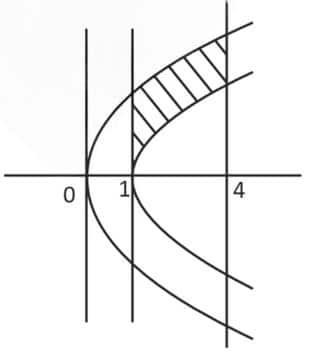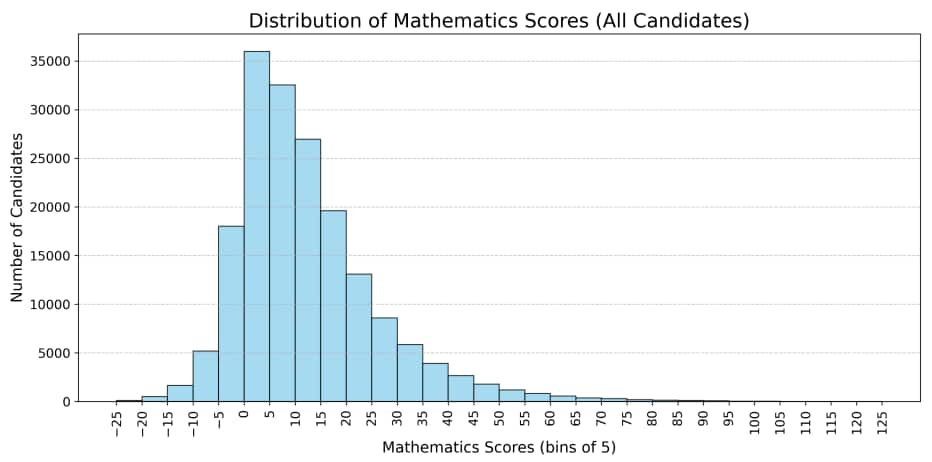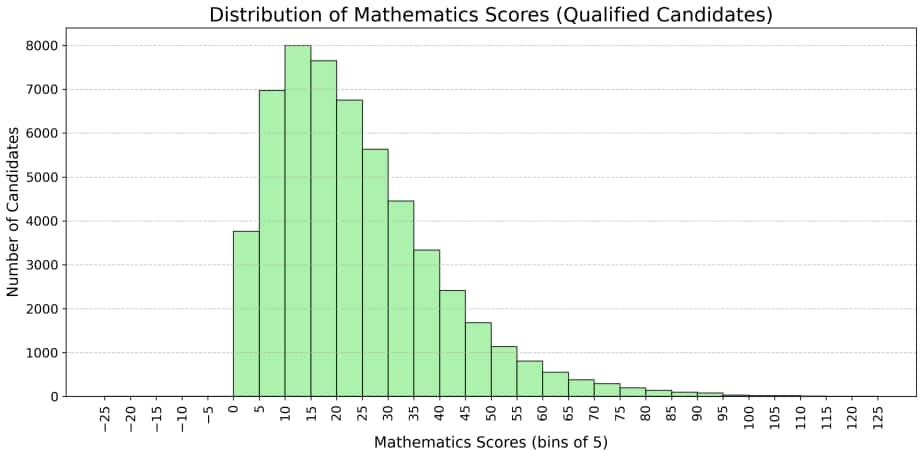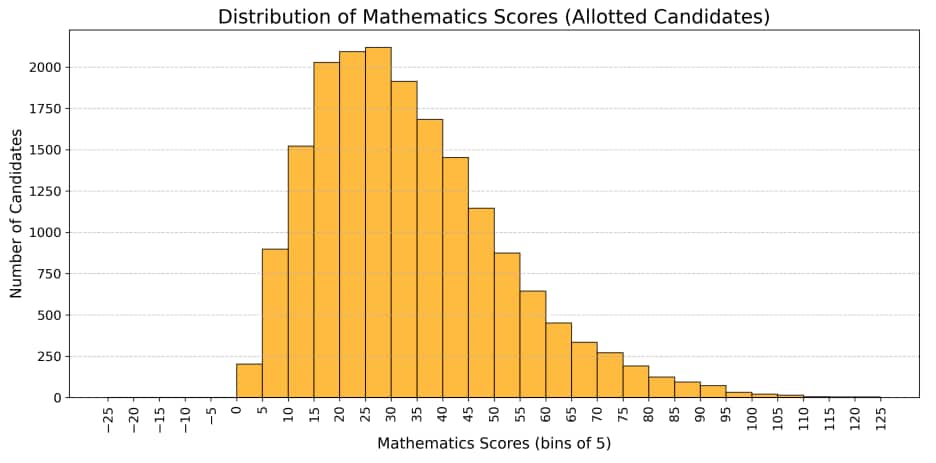UPES B.Tech Admissions 2026
Ranked #43 among Engineering colleges in India by NIRF | Highest Package 1.3 CR , 100% Placements
JEE Advanced Mathematics 2025 Analysis : If you are preparing Maths for JEE Advanced 2026, then mastering concepts and understanding the exam trends and difficulties faced by students is a must. In order to do that, analysis of questions that are skipped, attempted incorrectly, or correctly solved provides information about preparation patterns. The JEE Advanced 2025 Mathematics analysis shows that the paper is a blend of conceptual and lengthy questions. These performance-based trends of JEE Advanced questions for the year 2025 provide a detailed division of performance analysis and provide students with insight into patterns of errors and accuracy. JEE Main 2026 registration has already started and students can register from 31 October 2025 to 27 November 2025, session 1 is scheduled from 21 to 30 January 2026.
This Story also Contains

The Mathematics section of JEE Advanced 2025 provides insights into how candidates performed across Paper 1 and Paper 2. A question-wise analysis highlights accuracy, difficulty levels, and common mistakes, helping aspirants identify their strengths and weakness for Maths preparation. Given below table highlighting the question-wise performance of candidates:
Paper 1/2 | Question Number | Not Attempted | % Not Attempted | Full Marks | % Full Marks | Partial Marks | % Partial Marks | Wrong Response | % Wrong Response |
1 | Q1 | 112050 | 62.1 | 41763 | 23.15 | 26609 | 14.75 | ||
1 | Q2 | 96798 | 53.65 | 12225 | 6.78 | 71399 | 39.57 | ||
1 | Q3 | 86074 | 47.71 | 13017 | 7.21 | 81331 | 45.08 | ||
1 | Q4 | 130108 | 72.11 | 14774 | 8.19 | 35540 | 19.7 | ||
1 | Q5 | 112257 | 62.22 | 18740 | 10.39 | 24754 | 13.72 | 24671 | 13.67 |
1 | Q6 | 99402 | 55.09 | 13456 | 7.46 | 25518 | 14.14 | 42046 | 23.3 |
1 | Q7 | 73897 | 40.96 | 67448 | 37.38 | 16231 | 9 | 22846 | 12.66 |
1 | Q8 | 48467 | 26.86 | 7400 | 4.1 | 124555 | 69.04 | ||
1 | Q9 | 62418 | 34.6 | 9929 | 5.5 | 108075 | 59.9 | ||
1 | Q10 | 59356 | 32.9 | 2607 | 1.44 | 118465 | 65.66 | ||
1 | Q11 | 44242 | 24.52 | 10824 | 6 | 125356 | 69.48 | ||
1 | Q12 | 72209 | 40.02 | 15438 | 8.56 | 92775 | 51.42 | ||
1 | Q13 | 61269 | 33.96 | 34458 | 19.1 | 84695 | 46.94 | ||
1 | Q14 | 93155 | 51.63 | 49710 | 27.55 | 37557 | 20.82 | ||
1 | Q15 | 75310 | 41.74 | 68008 | 37.69 | 37104 | 20.57 | ||
1 | Q16 | 90878 | 50.37 | 36060 | 19.99 | 53484 | 29.64 | ||
2 | Q1 | 96493 | 53.48 | 42964 | 23.81 | 40965 | 22.71 | ||
2 | Q2 | 93845 | 52.01 | 44421 | 24.62 | 42156 | 23.37 | ||
2 | Q3 | 121166 | 67.16 | 21740 | 12.05 | 37516 | 20.79 | ||
2 | Q4 | 109655 | 60.78 | 31678 | 17.56 | 39089 | 21.67 | ||
2 | Q5 | 114541 | 63.49 | 16914 | 9.37 | 13405 | 7.43 | 35562 | 19.71 |
2 | Q6 | 141728 | 78.55 | 6315 | 3.5 | 11588 | 6.42 | 20791 | 11.52 |
2 | Q7 | 120343 | 66.7 | 22270 | 12.34 | 14409 | 7.99 | 23400 | 12.97 |
2 | Q8 | 90829 | 50.34 | 5677 | 3.15 | 54822 | 30.39 | 29094 | 16.13 |
2 | Q9 | 29956 | 16.6 | 52191 | 28.93 | 98275 | 54.47 | ||
2 | Q10 | 42553 | 23.59 | 11987 | 6.64 | 125882 | 69.77 | ||
2 | Q11 | 42944 | 23.8 | 27769 | 15.39 | 109709 | 60.81 | ||
2 | Q12 | 43507 | 24.11 | 15516 | 8.6 | 121399 | 67.29 | ||
2 | Q13 | 43671 | 24.2 | 5067 | 2.81 | 131684 | 72.99 | ||
2 | Q14 | 43741 | 24.24 | 21967 | 12.18 | 114714 | 63.58 | ||
2 | Q15 | 46725 | 25.9 | 17356 | 9.62 | 116341 | 64.48 | ||
2 | Q16 | 56258 | 31.18 | 6677 | 3.7 | 117487 | 65.12 |
The most skipped questions in JEE Advanced Maths were primarily from topics like Matrices, 3D Geometry, Probability, and Integral Calculus. For example, in Paper 1, Q4 (Matrices) had a 72.11% skip rate, while in Paper 2, Q6 (Integral Calculus) was skipped by 78.55% of candidates.
Paper 1
Question Number | % Not Attempted | Chapter Name | Concept Name |
Q4 | 72.11 | Matrices and determinants | Transpose of a matrix |
Q5 | 62.22 | Three-dimensional geometry | Line of Intersection of Two Planes and Angle Between a Line and a Plane |
Q1 | 62.1 | Binomial Theorem and Its Simple Applications | General Term of Binomial Expansion |
Q6 | 55.09 | Sets, Relations and Functions | Onto Function or Surjective |
Q2 | 53.65 | Probability and Statistics | Conditional Probability |
Paper 2
Question Number | % Not Attempted | Chapter Name | Concept Name |
Q6 | 78.55 | Integral calculus | Area Bounded by Two Curves |
Q3 | 67.16 | Trigonometry | Inverse Trigonometric Function |
Q7 | 66.7 | Coordinate geometry | Line and the Ellipse |
Q5 | 63.49 | Matrices and determinants | Properties of the Determinant of a Matrix |
Q4 | 60.78 | Coordinate geometry | Point of Intersection of a Pair of Straight Lines |
From the given data, it is clear that a significant number of candidates chose to leave particular questions in both Paper 1and Paper 2 unattempted, shown in the statistics of Not Attempted and % Not Attempted. In Paper I, questions with the highest percentage of skipped responses were Q4 , Q5 and Q1 . The least skipped response was for Q2. Paper 2, on the other hand, had even higher skips, with Q6 being the most skipped question, touching 141,728 candidates, followed by Q3 and Q7. From this table it is clear that Paper 2 questions had a higher percentage of non attempts compared to Paper.
Detailed Concept-wise Analysis of JEE Advanced Mathematics 2025 Paper 1 & Paper 2 is given below:
Paper 1/2 | Question Number | Chapter Name | Concept Name |
1 | Q3 | Limits, Continuity and Differentiability | Monotonicity (Increasing and Decreasing Function) |
1 | Q7 | Complex numbers and quadratic equations | Modulus of complex number and its Properties |
1 | Q8 | Sets, Relations and Functions | Reflexive, Symmetric and Transitive relation |
1 | Q9 | Vector algebra | Section Formula |
1 | Q10 | Permutations and combinations | FUNDAMENTAL PRINCIPLE OF COUNTING |
1 | Q11 | Limits, Continuity and Differentiability | Monotonicity of Composite Function |
1 | Q12 | Sequences and Series | Arithmetic Progression |
1 | Q13 | Differential equations | Linear Differential Equation |
1 | Q14 | Probability and Statistics | Dispersion (Variance and Standard Deviation) |
1 | Q15 | Limits, Continuity and Differentiability | Maxima and Minima of a Function |
1 | Q16 | Vector algebra | Vector (or Cross) Product of Two Vectors |
2 | Q1 | Limits, Continuity and Differentiability | Differentiability and Existence of Derivative |
2 | Q2 | Coordinate geometry | Locus and its Equation |
2 | Q8 | Limits, Continuity and Differentiability | Maxima and Minima of a Function |
2 | Q9 | Differential equations | Differential equations with variables separable |
2 | Q10 | Binomial Theorem and Its Simple Applications | Greatest Term (numerically) |
2 | Q11 | Probability and Statistics | Total Probability Theorem and Bayes' Theorem |
2 | Q12 | Vector algebra | Linear Dependent Vectors |
2 | Q13 | Complex numbers and quadratic equations | Argument of complex number |
2 | Q14 | Sets, Relations and Functions | Composition of function, Condition for Composite Function |
2 | Q15 | Trigonometry | Trigonometric Identities |
2 | Q16 | Integral calculus | Fundamental Formulae of Indefinite Integration |
Question: Let
Then which of the following statements is (are) TRUE?
1-
2-
3- Area of
4- Area of
Correct Option:- 1 and 3
Solution:-
Given: The parabola is
Let a chord of this parabola have midpoint
Now,
Thus, the locus
We'll check if these points lie on the line, by putting the values,
But
Thus, point
Now find the area
- Parabola
- Curve
- Vertical lines
The area of region
Option 3 is also correct

Hence, the correct answers are option 1,3.
Double Concept
In this question two ideas are mixed using parameters for the parabola and then solving with definite integration. Many students get confused about which method to start with. Some try direct integration without using parameters, which takes much longer. Because it mixes topics, many students prefer to avoid it.
Confusion with “Region in First Quadrant”
When students read this part, they have to imagine the shapes of the curves
They spend extra time just trying to draw and compare them, which take up so much time in the final area calculation.
Two-Stage Question Format
Even after finding the locus
Under exam pressure, students like quick, one-step answers. Questions with many steps feel too long and time-consuming.
National level exam conducted by VIT University, Vellore | Ranked #16 by NIRF for Engg. | NAAC A++ Accredited
100% Placement Record | Highest CTC 54 LPA | NAAC A++ Accredited | Ranked #62 in India by NIRF Ranking 2025 | JEE & JET Scores Accepted
Answer-Type (Multiple Correct)
The question has options (A–D) where more than one can be correct. Students know they must be fully sure, because partial answers don’t give marks.
With so many steps: locus, integration, and checking points, the chances of making a mistake are high, so many skip it.
Indirect Parametrisation Trick
The simple method is to use parameters for the parabola:
In short, the question looks too lengthy, indirect and too integration-heavy at first sight. It involves two different conceptual tricks (parametrisation of a parabola, simplification of the area formula). It is multi-stage with multiple correct options, raising the risk of wasted time and no marks.
The Mathematics JEE Advanced 2025 analysis also highlights the biggest trap questions. For instance, Paper 2 Question 13 Complex Numbers saw 72.99% wrong attempts. These questions appeared straightforward but were full of pitfalls, showcasing common mistakes in JEE Advanced Mathematics like sign errors, misusing formulas, or ignoring principal values.
Question Number | % Wrong Response | Chapter Name | Concept Name |
Q11 | 69.48 | Limits, Continuity and Differentiability | Monotonicity of Composite Function |
Q8 | 69.04 | Sets, Relations and Functions | Reflexive, Symmetric and Transitive relation |
Q10 | 65.66 | Permutations and combinations | Fundamental principle of counting |
Q9 | 59.9 | Vector algebra | Section Formula |
Q12 | 51.42 | Sequences and Series | Arithmetic Progression |
Question Number | % Wrong Response | Chapter Name | Concept Name |
Q13 | 72.99 | Complex numbers and quadratic equations | Argument of a complex number |
Q10 | 69.77 | Binomial Theorem and Its Simple Applications | Greatest Term (numerically) |
Q12 | 67.29 | Vector algebra | Linear Dependent Vectors |
Q16 | 65.12 | Integral calculus | Fundamental Formulae of Indefinite Integration |
Q15 | 64.48 | Trigonometry | Trigonometric Identities |
The analysis of wrongly attempted questions reveals that certain problems acted as traps widely attempted but rarely solved correctly. For instance, Q13 (Paper 2) saw 72.99% wrong responses, while Q10 (Paper 2) had 69.77% wrong responses. Similarly, Q11 (Paper 1) and Q8 (Paper 1) recorded 69.48% and 69.04% wrong responses, respectively. The common pattern across these questions was that the % Not Attempted values remained moderate (around 23–27%), meaning most students felt confident enough to try them. However, the % Full Marks was dismally low — only 1.44% for Q10 (Paper 2) and 2.81% for Q13 (Paper 2). This mismatch between high attempts and high wrong responses shows that these questions were either conceptually tricky, calculation-intensive, or designed with distractor options that lured students into errors. While questions like Q12 (Paper 1) with 40.02% not attempted but only 51.42% wrong responses, show that students consciously avoided tougher problems, reducing the wrong-attempt ratio.
Question: For a non-zero complex number
Then the value of
Correct Answer:- -2
Solution:
Let
Note
Thus
Using
Now
Finally,
Hence, the correct answer is -2.
Which
Period confusion: Some think
Geometric series mistakes: In the formula
Forgetting principal argument rules: Even if they get the complex sum correct, they sometimes write the angle as
Ignoring simple simplifications. The identity
Not checking the power pattern. Since 2025 is a multiple of 3 (and of
Interestingly, certain questions were the most solved questions in JEE Advanced Maths 2025. For example, Paper 1 Q15 (Maxima & Minima) had 37.69% full marks, while Paper 2 Q9 (Differential Equations) had 28.93%. These were largely direct applications of textbook concepts, explaining their higher accuracy.
Question Number | % Full Marks | Chapter Name | Concept Name |
Q15 | 37.69 | Limits, Continuity and Differentiability | Maxima and Minima of a Function |
Q7 | 37.38 | Complex numbers and quadratic equations | Modulus of a complex number and its Properties |
Q14 | 27.55 | Probability and Statistics | Dispersion (Variance and Standard Deviation) |
Q1 | 23.15 | Binomial Theorem and Its Simple Applications | General Term of Binomial Expansion |
Q16 | 19.99 | Vector algebra | Vector (or Cross) Product of Two Vectors |
Question Number | % Full Marks | Chapter Name | Concept Name |
Q9 | 28.93 | Differential equations | Differential equations with variables separable |
Q2 | 24.62 | Coordinate geometry | Locus and its Equation |
Q1 | 23.81 | Limits, Continuity and Differentiability | Differentiability and Existence of Derivative |
Q4 | 17.56 | Coordinate geometry | Point of Intersection of Pair of Straight Lines |
Q11 | 15.39 | Probability and Statistics | Total Probability Theorem and Bayes' Theorem |
Question: Let
Match each entry in List-I to the correct entry in List-II and choose the correct option.
List-I | List-II | ||
(P) | The minimum value of | (1) | 8 |
(Q) | The minimum value of | (2) | 9 |
(R) | The smallest natural number | (3) | 5 |
(S) | Number of | (4) | 6 |
(5) | 10 |
1)
2)
3)
4)
Correct Option:- 2
Solution:
Given:
(P): Find minimum
Define
Calculate derivative:
On
Evaluate:
For continuity,
Try
So minimum

(Q): Find minimum
Since
Set:
Solve quadratic inequality:
Roots:
Since

(R): Find smallest natural
Note:
For local minimum at
Check behavior near 3:
- For
- For
Since the factor
(S): Find number of points
is NOT differentiable.
-
-
Non-differentiable points are at
Number of such points = 5.
(P) : 9 (List-II (2))
(Q) : 8 (List-II (1))
(R) : 6 (List-II (4))
(S) : 5 (List-II (3))
Final matching:
Hence, the answer is option 2.
Each part is straight from the textbook and can be checked in one line.
(Q) comes down to checking the sign of a quadratic; the derivative is always positive because
(R) is about behaviour near a root:
(S) is counting points where
(P) is just checking values of a cubic in a small interval; its range is
No long algebra or tough integrals are needed
Each part just needs a short step or one inequality.
Numbers are simple
Intervals like
Checks are clear and fast
For monotonicity, check the coefficient sign; for local min, check even/odd power; for non-differentiability, check absolute-value breaks; for floor continuity, just see if an integer multiple lies in the interval. All can be done quickly under exam pressure.
In short, the question was straight from the textbook ideas. Each part needed only one quick check - sign of a quadratic, odd–even power rule, sharp corner of sine, or small range of a cubic. Numbers were easy, intervals small, and steps short. So students could solve it fast without long algebra.
For all candidates, the aggregate marks distribution shows the overall performance in JEE Advanced 2025. Given below this information using charts:



The JEE Advanced 2025 question trends clearly show that the toughest problems were those with:
Low % full marks,
Moderate attempts, but
Very high wrong response percentages.
Q. No. | % Not Attempted | % Full Marks | % Wrong Response | Chapter | Concept |
Q10 | 32.9 | 1.44 | 65.66 | Permutations and combinations | Fundamental principle of counting |
Q8 | 26.86 | 4.1 | 69.04 | Sets, Relations and Functions | Reflexive, Symmetric and Transitive relation |
Q11 | 24.52 | 6 | 69.48 | Limits, Continuity and Differentiability | Monotonicity of Composite Function |
Q9 | 34.6 | 5.5 | 59.9 | Vector algebra | Section Formula |
Q12 | 40.02 | 8.56 | 51.42 | Sequences and Series | Arithmetic Progression |
The most difficult questions in JEE Advanced Maths Paper 1 (Q8, Q9, Q10, Q11, Q12) are difficult due to a mix of high wrong response rates and very low full marks percentages. Questions like Q8 and Q11 had nearly 70% wrong attempts, showing that while most students tried them, the trap-based nature or multiple-case logic led to errors. Q10 stood out with the lowest full marks (1.44%), suggesting it required multi-step solving where even small mistakes caused failure. Q9 and Q12 had higher non-attempt rates (34-40%), reflecting the intimidating or lengthy nature of these problems, though Q12 still had slightly better full marks, indicating it was solvable with strong conceptual clarity. Overall, these questions combined conceptual depth, calculation intensity, and cleverly designed traps, making them the toughest of the paper and pushing up their difficulty index values.
Q. No. | % Not Attempted | % Full Marks | % Wrong Response | Chapter | Concept |
Q13 | 24.2 | 2.81 | 72.99 | Complex numbers and quadratic equations | Argument of complex number |
Q16 | 31.18 | 3.7 | 65.12 | Integral calculus | Fundamental Formulae of Indefinite Integration |
Q10 | 23.59 | 6.64 | 69.77 | Binomial Theorem and Its Simple Applications | Greatest Term (numerically) |
Q12 | 24.11 | 8.6 | 67.29 | Vector algebra | Linear Dependent Vectors |
Q15 | 25.9 | 9.62 | 64.48 | Trigonometry | Trigonometric Identities |
The toughest questions in JEE Advanced Maths Paper 2 (Q13, Q16, Q10, Q12, Q15) stood out due to their very low full marks percentages coupled with extremely high wrong response rates. Q13, from Complex Numbers and Quadratic Equations, was the most difficult with only 2.81% full marks and a massive 72.99% wrong response, showing that while most students attempted it, the conceptual traps and tricky algebra led to widespread failure. Q16 (Integral Calculus) also saw only 3.7% full marks and 65.12% wrong responses, indicating lengthy solving or integration pitfalls. Q10 and Q12, from Binomial Theorem and Vector Algebra, respectively, had slightly better full marks (6.64% and 8.6%) but still suffered from nearly 70% wrong attempts, reflecting complex application-based logic. Q15 (Trigonometry) showed the highest success of this set with 9.62% full marks, yet more than 64% wrong responses highlight it was not straightforward. Overall, these questions combined multi-step solving, conceptual depth, and trap-heavy design, making them the most challenging of Paper 2 and greatly influencing its overall toughness index.
With this analysis, aspirants can identify the most skipped questions in JEE Advanced Maths, avoid the common mistakes in JEE Advanced Mathematics, and practice more on the most attempted questions in JEE Advanced Maths 2025 that often become traps. By focusing on these JEE Advanced 2025 question trends and revising the JEE Advanced Maths solved questions 2025, candidates can strengthen their exam strategy.
Frequently Asked Questions (FAQs)
Mostly lengthy ones from Matrices, 3D Geometry, and Calculus. For example, Paper 2 Q6 (Integral Calculus) was skipped by nearly 79% of students.
Concept-based ones like Complex Numbers and Probability. But high attempts didn’t mean accuracy — Paper 2 Q13 (Complex Numbers) had 73% wrong answers.
Easy direct questions were solved well, while multi-step or tricky Algebra and Probability questions trapped most students.
On Question asked by student community
Hello,
Yes, many IITs now offer specialization BTech programs in AI and data science/engineering, separate from core CSE, while also providing AI/ML/robotics as electives or minors within CSE/other branches, with admission via JEE Advanced, but you'll find specific "robotics engineering" branches more at institutions like IITs/NITs, though IITs integrate robotics in AI/CSE.
I hope it will clear your query!!
Hello,
You can download the IIT JEE Last 5 Years Chapterwise PYQ's from the Careers360 website. Practising these papers will helps you to understand the exam pattern, to identify the important topics, to improve time management, and overall it enhances your exam preparation.
LINK: https://engineering.careers360.com/articles/jee-main-question-papers
Hope it helps!
Hello murali
No, your son is not eligible for OBC NCL for IIT JEE because you fall in the "creamy layer" occupational category, regardless of your current employment status or family income. Students whose family income is less than Rs. 8 lakhs annually and they are not belong to the "creamy layer".
Note -
Thank You
Hello,
In 2025, IIT Madras JEE Advanced, closing ranks are around 171 for CSE, 306 for AI & Data Analytics, 849 for Electrical, about 1300 for Computational Engineering, around 1440 for Engineering Physics, 2468 for Mechanical, and about 6112 for Civil.
To know more access below mentioned link:
https://engineering.careers360.com/articles/jee-advanced-cutoff-for-iit-madras
Hope it helps.
Hello,
JEE Advanced College Predictor 2026 is an AI driven tool created by Careers360.
This JEE Adv college predictor tool uses the latest rank vs college details to give the most accurate information on best available colleges based on JEE Advanced ranks.
Here is the link where you can access the tool : JEE Advanced College Predictor 2026
Hope it helps !
Among top 100 Universities Globally in the Times Higher Education (THE) Interdisciplinary Science Rankings 2026
Ranked #43 among Engineering colleges in India by NIRF | Highest Package 1.3 CR , 100% Placements
100% Placement Record | Highest CTC 54 LPA | NAAC A++ Accredited | Ranked #62 in India by NIRF Ranking 2025 | JEE & JET Scores Accepted
National level exam conducted by VIT University, Vellore | Ranked #16 by NIRF for Engg. | NAAC A++ Accredited
NAAC A+ & NBA Accredited | QS I-Gauge Gold rated University | Highest CTC 52 LPA | 300+ Companies | Avail Scholarships Application Deadline: 28th Feb’26
Recognized as Institute of Eminence by Govt. of India | NAAC ‘A++’ Grade | Upto 75% Scholarships